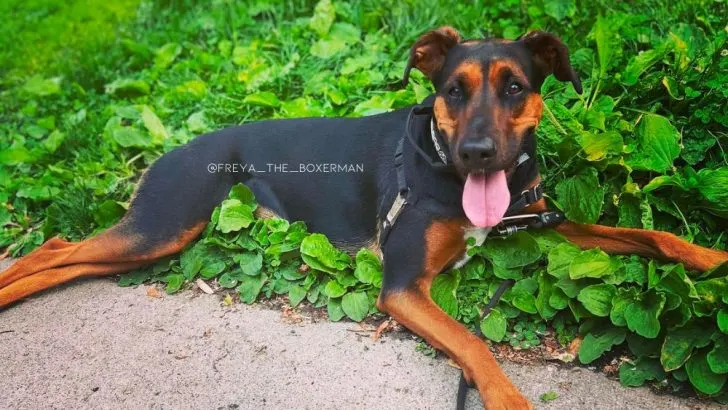What’s better than a Doberman Pinscher or a Boxer? A Doberman Boxer mix!
When we say ‘designer dogs’, most people imagine little velcro monsters like Goldendoodles or Pomskies. However, not all hybrid breeds are stereotypically cute and small. Some of them are designed to be the ultimate guard dogs.
This is the case with Boxerman Pinscher, a Boxer Doberman mix bred to keep us all safe while also being a great family pet everyone will fall in love with.
Let’s learn everything there is to know about this amazing hybrid dog!
Doberman Boxer Mix Overview
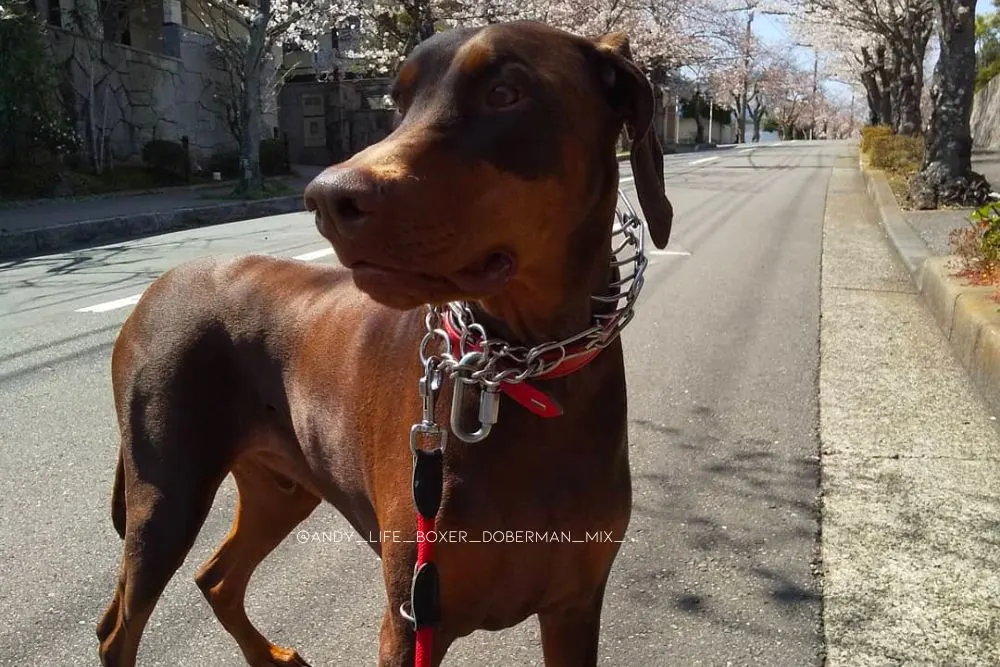
| Height | Weight | Lifespan |
| 25-28 inches | 55-100 lbs | 10-13 years |
| Activity Level | Grooming Needs |
| Very High | Low |
Breed History
It’s challenging to pinpoint the exact moment when the first Doberman Boxer mix was bred. However, we can understand the mixed breed a bit more if we look at the parent breeds and their history.
Both Boxer and Doberman originate from Germany, and both were bred to be guard dogs and fight dogs. They were used as war dogs during World War II, which is likely where their somewhat bad reputation stems from.
Both were first bred in the 1800s, but Doberman is considered a bit older, as it was first bred by Karl Friedrich Louis Dobermann in the 1880s.
On the other hand, while you can find traces of the old Boxer breed in ancient times, what we know as Boxer today was created in the late 19th / early 20th century.
The American Kennel Club (AKC) recognized the Boxer breed in 1904, and in 2024, they were the 16th most popular dog in the US, according to Forbes.
Doberman Pinscher came to the US in 1908, and breeders quickly started selling them as police dogs and watchdogs. According to Forbes, they hold the 15th spot on their Most Popular Dog Breeds in the US list.
It seems like our Boxerman has rather popular parent breeds, as well as some huge shoes to fill!
Boxerman Breed Appearance
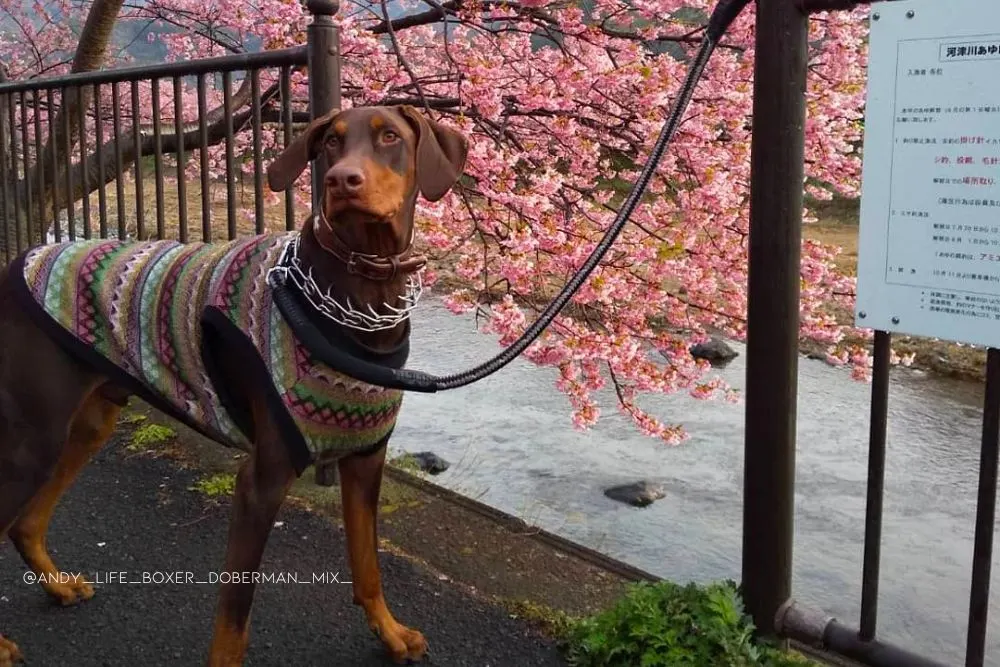
It’s challenging to predict a mixed breed’s appearance, even when they’ve existed for a while. This is due to the many different genes two parent breeds have, and it’s nearly impossible to know which ones will prevail.
Most of the time, though, a Boxerman will look like a Doberman Pinscher with a stockier Boxer build.
Let’s look deeper into things.
Height and Weight
One thing is certain: A Boxerman puppy will grow to be a large dog. Boxer and Doberman are big canines, with an average height of 25 and 28 inches, respectively.
This means you can expect their offspring to be anywhere between 25 and 28 inches, but some can grow to be a bit taller or shorter.
When it comes to the Boxerman’s weight and build, this is where things get a bit trickier.
Doberman is a tall, slim, and muscular dog. They are known as the devil dogs due to their silhouette, and many people find them to look rather scary. Their average weight is anywhere between 75 and 100 lbs.
On the other hand, Boxer has a stockier build. They are cousins of Bulldogs and have their short and thick bodies. However, you might be surprised to hear that adult Boxers are somewhat lighter than Dobermans, weighing between 55 and 70 lbs.
Boxerman can have the build of either parent or even somewhere in between. In general, depending on their size, they will weigh between 55 and 100 lbs but will typically be around 70 lbs.
General Appearance
The Boxerman will look anywhere between its parents.
If you look at Boxer or Doberman coat colors, these pups usually have a black, red, fawn, or brindle coat. Standard Doberman markings can be present, as well as white and black face markings typical for a Boxer.
Their face can vary, as they can inherit the Doberman’s long muzzle or the brachycephalic face of a Boxer.
Both Boxers and Dobermans are born with floppy triangular ears and long tails, so their offspring will inherit these traits. You can opt for ear cropping or tail docking if you’d like, or you can leave them looking natural.
Boxerman Temperament
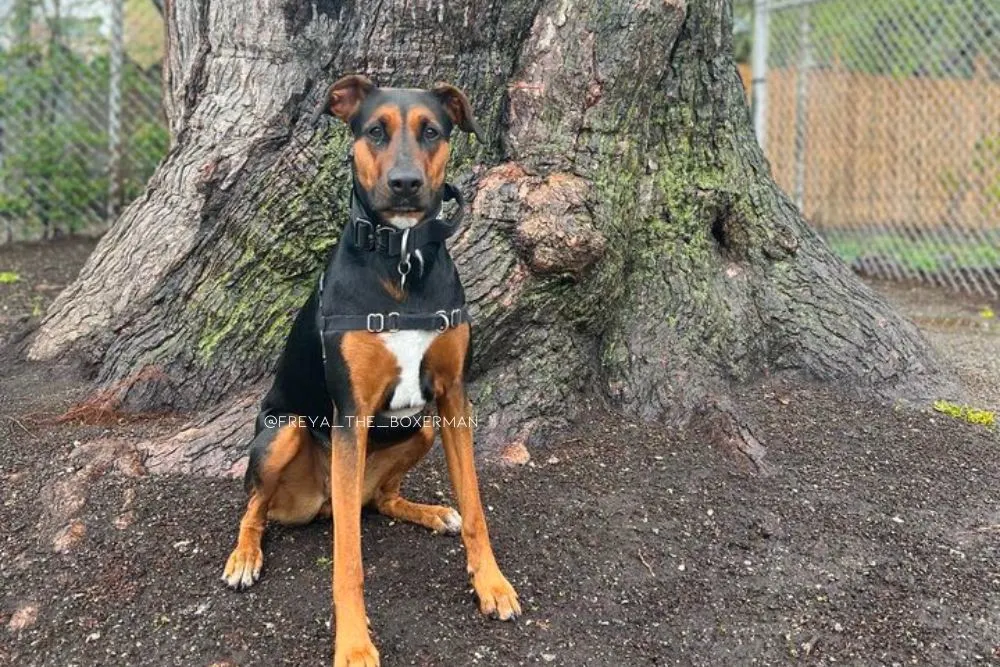
One thing you are probably most worried about is the Doberman Boxer mix’s temperament. Both parent dogs are (wrongly) considered aggressive, so what does this mean for their mix?
Boxerman Pinscher is a territorial and protective dog, no doubt about that. These dogs will keep you and your home safe no matter what.
However, this doesn’t mean they have aggressive tendencies, at least not if you’ve got them from breeders who have carefully selected the parent dogs.
This is why it’s important to know who you’re buying or adopting this dog from. If a Boxerman parent was unpredictable and aggressive, chances are the pup will inherit this bad behavior, and this can end in a disaster.
Still, early socialization is the key if you want to make sure their prey drive and territorial nature are kept at bay.
Boxerman will love kids, but due to its size, you might not want to leave it alone with little children. These are active dogs that have much energy, and they’ll want to jump and run around all the time, and this can be dangerous for toddlers or small children.
If you’ve trained and socialized your pup from an early age, you will quickly see that these are some of the goofiest and funniest dogs of all time! They have a big personality and will love to make you laugh.
Also, they might forget their size and try to be lap dogs or will attempt to get into your bed at night.
Trainability
As both the Doberman and the Boxer are considered some of the most intelligent breeds, training a Boxerman should be a piece of cake.
However, this isn’t exactly the case. You’ll need to start training them from an early age, and you need to be dedicated.
Boxers are a somewhat stubborn breed, and they will use any mistake you make to let their temperament get through. This character can be passed onto Boxerman, so be careful.
Never punish your dog when they do something wrong! This won’t make them obey you; it will only result in behavioral problems.
Positive reinforcement is the best way to teach your Boxerman how to behave.
Also, these are active dogs with high energy levels. If they are bored or need exercise, they won’t be in the mood to listen to your commands.
Make sure to train them after physical activity or a long walk so their focus will be on you and you alone.
Finally, contacting a professional trainer might help, and I would advise any Boxerman owner to take their dog to at least a few training classes.
Sadly, the truth is that an untrained Boxerman can become a dangerous Boxerman. This isn’t something you can neglect if you want to own this breed.
Grooming Needs
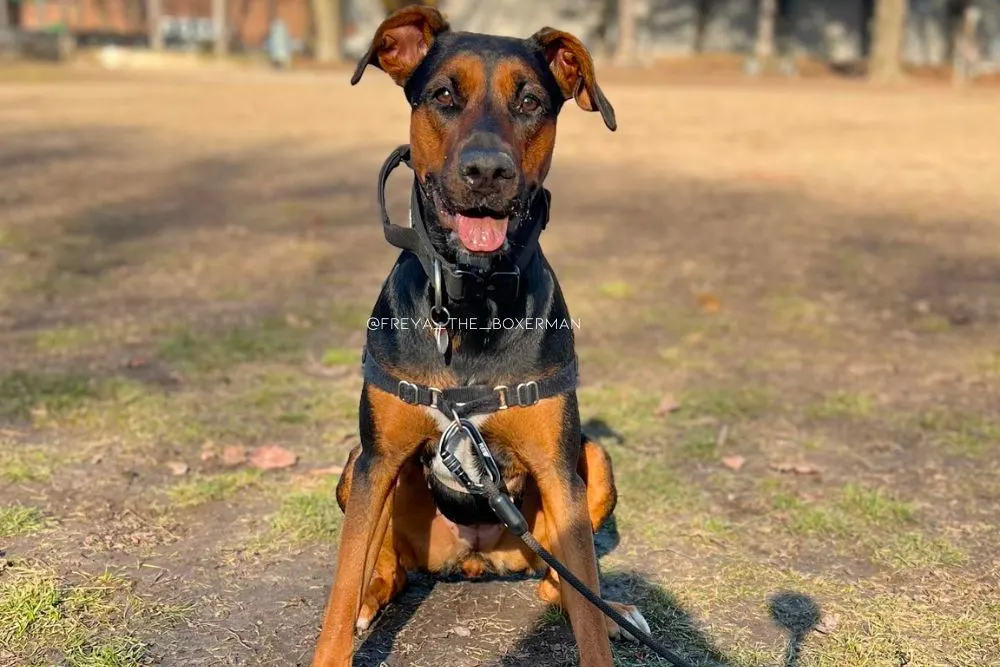
Boxermans have a short coat, so they don’t have any challenging grooming requirements. All you need to do is brush and wash them occasionally, and they’ll look clean and shiny. Just don’t wash them too often, as this will remove important oils their skin produces.
The only issue is that, while both Boxers and Dobermans have single coats, they will shed moderately, especially in spring and fall. The same goes for their mix.
This also means they are not hypoallergenic, which is another thing to keep in mind before deciding to own one.
Health
In general, mixed-breed dogs are considered to be healthier than their purebred parents. However, they might develop any health issues that plague their parent breeds, although the chances of this happening are lower.
Some health problems a Boxerman might experience include:
- Dilated cardiomyopathy (DCM)
- Hip dysplasia
- Elbow dysplasia
- Gastric dilatation volvulus (GDV), also known as bloat
- Von Willebrand’s disease (vWD)
- Progressive retinal atrophy (PRA)
- Various types of tumors
Next to these health concerns, Boxermans might be sensitive to extreme temperatures due to their short, single coat.
Luckily, Boxerman breed maintenance isn’t too challenging. Make sure you follow the dog’s diet requirements, which your veterinarian will prescribe, and give them plenty of exercise. This, combined with regular vet visits, will make sure your pup lives long and healthily.
Doberman Boxer Mix Lifespan
Doberman Boxer mix has a fairly long lifespan for a large breed.
These pups can live anywhere between 10 and 13 years, but some might grow even older!
Does AKC Recognize Boxerman?
Some dog owners want their dogs to be recognized by the AKC. They might want to participate in dog shows or just want to make sure they have the right breed.
However, AKC only recognizes purebred dogs. To register a dog breed, there needs to be a breed standard, among other things.
In other words, when you look at a dog, you need to be able to recognize what breed he or she is immediately.
Unfortunately, this isn’t the case with Boxerman. This is a mixed breed dog, and as such, you won’t be able to participate in conformation shows or get any registration papers.
This doesn’t make them faulty, however. They can be as good pets and companions as any other purebred dog, so don’t let this discourage you from getting one.
Should You Get a Doberman Boxer Mix?
So, is a Doberman Boxer mix the best dog for you, or should you check out some other (mixed) breeds? It all depends on your requirements and capabilities.
Boxerman is a hard-working guard dog with a goofy side. They are friendly dogs; however, they require lots of training and socialization to control potential aggression.
Due to their large size, an untrained Boxerman is challenging to control, so make sure you can do just that.
If you are someone who doesn’t have the time and dedication it takes to train these dogs, or if you have really small kids, this isn’t the right dog for you.
On the other hand, if you want a dog that will make you feel safe, have the time to train them, and want to take advantage of somewhat lower puppy prices these dogs have, go for it!
Boxermans are as lovely as any purebred dog. Give them a chance!

Vanja’s passion for writing started at an early age, which is why she pursued Journalism as her college degree. She can research any topic and find all the information before you bat an eye, which is a great thing for her job but a terrible one for her husband.
Even as a young child, she fell in love with everything fluffy – but dogs have a special place in her heart due to her childhood companion, a Corgie named Archie.
Motivated by her experiences and driven by a desire to give back to her four-legged companions, she spends her free time volunteering at a local dog shelter.
